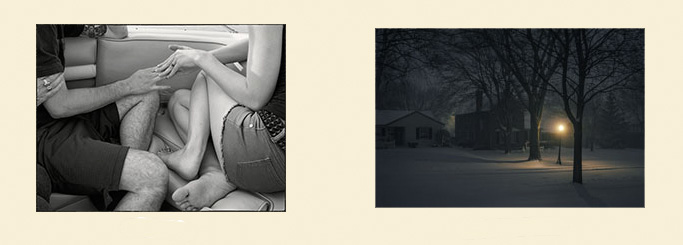This is the middle level of photographs in our current fundraising sale. Both are among my most popular pictures, and both are from TOP posts.
The one on the left is from a "Random Snap" post from last July, only this one was taken with the OM-D E-M5. I didn't get along with the E-M5 (lots of people do; I've explained very carefully elsewhere that my eventual rejection of it isn't a rap against the camera), but I really liked its results. (I'm hoping to learn this summer whether I like the E-M1's pictures as much.)
I have to note that I'm one of those photographers whose life's work in photography was interrupted by the onset of the digital era. I shot 35mm B&W for twenty years (1980–2000) and had amassed a pretty nice body of work. I've never quite been able to continue that body of work with digital—mainly because B&W is no longer "natural" to the medium of photography, and because it took a while for the technology to start yielding acceptable results (a point we're well past now, of course).
Along the way I've made various attempts to restart my old "way of working," without success. However, the "hands" picture is probably the single digital picture that comes closest, in subject and rendition, to my "real" work. It might also be the digital B&W print I'm personally happiest with—Ctein got it just right.
"Hands" was a pure snapshot (you can see the "proof sheet" at the link)—I was just goofin' around with the camera in a speedboat on Burt Lake in Michigan. It shows my son and his ex-girlfriend Kirsten, and his grandmother's hand is also visible.
The picture on the right is another pure snapshot—I was writing a post about the weather on December 1st, 2006, when TOP was still very new, and I was almost too lazy to go to the door and snap a quick picture of the snow to illustrate the post with. Good thing I made the effort—that picture has earned more than $20,000 over the years! It was taken with the K-M 7D and the Minolta 28–75mm lens made for Minolta by Tamron in China.
And you know how criminals always return to the scene of the crime? I've snapped that same scene, more or less, a number of times since then, even in snow. Nothing ever looks anything like this shot, of course. And now that big old elm tree is gone, too. The world is a river, and that goes for the visual world, too.
Mike
P.S. I'm not going to get to the other two prints tonight (Sunday). I haven't had a minute free all day and I'm running out of steam. But I'll write about them in the morning, before the sale ends, never fear.
Original contents copyright 2014 by Michael C. Johnston and/or the bylined author. All Rights Reserved. Links in this post may be to our affiliates; sales through affiliate links may benefit this site.
(To see all the comments, click on the "Comments" link below.)
Featured Comments from:
Andrew Kirk: "How does one earn $20,000 from a single image?"
Mike replies: Selling prints. This is the second TOP sale I've had of this picture, and it has sold a number of times privately. Never for more than $300, but it adds up. This has never sold as stock or for advertising, but those are two more ways for a picture to earn income. Peter's Paris Rooftops picture has sold in the six figures as a poster, which is yet another way.




I really like both of these pictures.
Why not return to the old way of working, if you aren't satisfied? 35mm film development is easy, even without a darkroom. You can use the D800 (and I'm sure many other cameras) as a fantastic scanner if you pickup a slide copy system. I documented my experience with the D800E and Nikon bellows at the site linked to my name. I really prefer it to black and white conversions for some reason. Possibly just because I like shooting the old cameras.
Posted by: Larry Gebhardt | Monday, 07 April 2014 at 08:08 AM
Mike,
Not ever having made a living from photography (corporate IT career for decades), I'm intrigued/fascinated/astonished by the idea that a single snapshot can earn $20,000. For those not in your world, and seeking to understand it, how does one DO that?
Thanks
Posted by: Mike R | Monday, 07 April 2014 at 10:01 AM
"Hands" is the best photo of the bunch. Wish it was in my budget.
Posted by: Peter Randall | Monday, 07 April 2014 at 05:40 PM
OK, days have passed and nobody has addressed the elephant in the room. So I will.
How does a (very nice) photo of some trees and a street lamp generate more than $20,000 in revenue? This is not a criticism of the photograph — it’s beautiful — I just don’t know how ANY photograph generates that kind of money (notwithstanding prints from people who have been blessed with the magical endorsements of the art world, or are otherwise "known" for their prints).
Is that from print sales? Advertising? Something else?
I realize there are boundaries when it comes to such disclosures, so feel free to ignore this question if I’m crossing any. But loyal and curious readers want to know. Personally, I’m always a bit flabbergasted whenever anyone makes money from print sales, which is a sign of my own disillusionment combined with my head possibly being part way up my shady spot. After all, images are so ubiquitous and “everyone’s a photographer,” etc., that it amazes me that people put down cash in three or four digits for a print. I’m not saying it’s wrong; not at all. I’m just amazed that it happens.
Posted by: Ed Hawco | Wednesday, 09 April 2014 at 10:53 AM